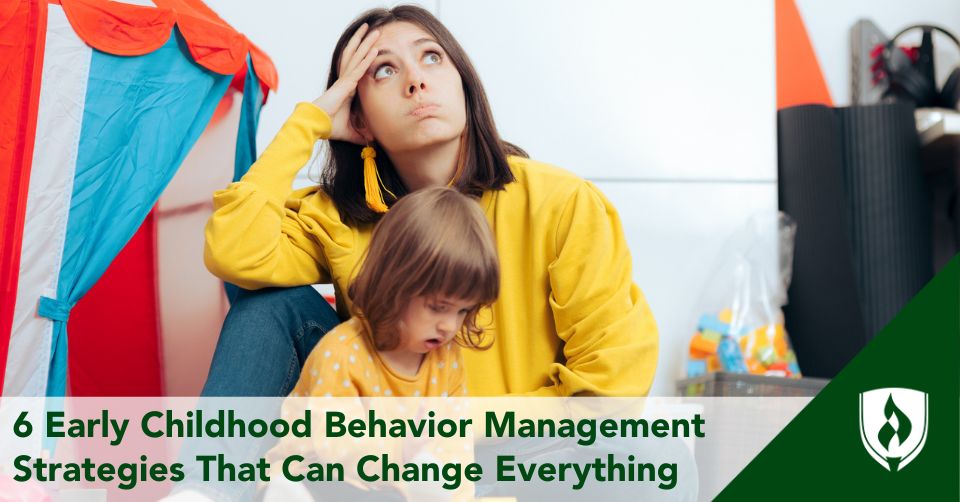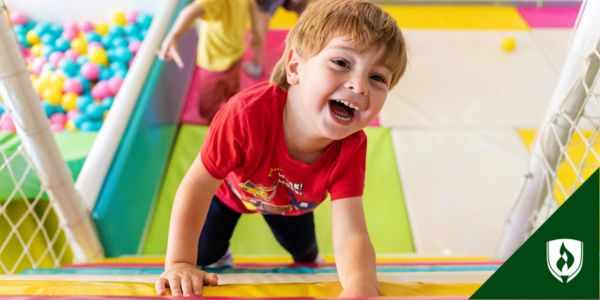6 Early Childhood Behavior Management Strategies That Can Change Everything
By Joni Kuhn on 09/19/2024

"Look at me when I'm talking to you!"
"Did you hear me?? Repeat what I just said!"
"Pick that up RIGHT NOW, Mister!"
Do any of those phrases sound familiar? Adults in our society have a tendency to treat children in ways we would never treat our friends, spouses or partners. I have never yelled phrases like that at my husband, for example. I can't imagine speaking to anyone else like that.
Have you ever wondered why it seems to be completely acceptable to speak this way to the youngest humans in our society? The ones most invested in learning how the world works and how to find their place in it? The ones who have literally been alive for 60 months or less, if we are talking about children who, at the oldest, are 5 years old?
I have always found it to be odd. Consider this—How would you react or behave if someone spoke to you in that manner?
You'd probably display some problematic behavior too, right?
The internet is full of early childhood behavior management strategies to get children to calm down or exhibit the more compliant, positive behavior that adults want to see. And many of these ideas can encourage good behavior. After all, who wouldn't spend a day quietly smiling and nodding for the right incentive?
But if you want the children in your care to truly grow and develop the skills they need to thrive, your approach to behavior management needs to go deeper than getting them to stop doing/start doing something. The problem is even present in the term "behavior management." This implies that a child's behavior is something to be dealt with, controlled or otherwise handled. Something "wrong" or "bad."
In all my years of early childhood development, I've come to understand that helping children learn how to behave and learn as they grow requires a different approach from adults and educators. Instead of focusing on the children, we also need to focus on the adults who teach and care for them every day.
It's easy to get to the end of your rope when you're facing young children. If you are looking for behavior management strategies that truly help children long-term, read on!
1. Pay attention to their developmental phase, not a specific behavior
When I come across early childhood articles about "strategies to improve children's behavior," I always get excited—this is something everyone could benefit from knowing!
Then I read the article, and I am quickly disappointed. The strategies are always what to do to children or what to do at children; what not to "let them get away with" or how to "teach them responsibility."
There is rarely any discussion regarding what kind of support children need from the adults and educators in their lives. What should they need to learn and do?
Parents, families and educators need to understand basic child development processes. Classroom management strategies that leave this fundamental knowledge out will miss the mark.
Trust me—your stress level will subside when you know what behaviors to expect for children in a certain age group, according to their stage of development.
With that understanding, your expectations of how they should act become calmingly realistic, instead of chaotically unrealistic.
This reduces anxiety for everyone involved.
2. Decode their behavior to learn their needs
Educators and adults tend to lump children's behavior into categories such as good, bad, right, wrong, naughty, selfish and behaving in ways (on purpose) just to "push my buttons."
(Oh, if only a very young child's brain was developed enough to manipulate us in the ways we imagine!)
The categories we put children's behavior in are highly subjective, which also leads to confusing and conflicting communication. Behavior is not inherently good or bad, right or wrong, naughty or selfish.
What you think is bad, someone else might not. What you think is wrong, someone else might not. The thing is—behavior is communication.
There is always a valid reason for a child's behavior. Always.
The difficult part is figuring out what that reason is. Behavior often results from a need that is not being met. Basic needs for children are food, shelter, comfort, sleep and attention (yes, attention is an actual human need). Children who have their attention-cup filled, don't go looking for attention.
Educators need to understand that children who seek attention need that attention. They don't "just" want it. Their attention-cup is empty. We need to help fill it up!
Here are some examples of challenging behaviors that communicate an unmet need.
- Hitting or kicking
- Yelling or being defiant
- Hiding under a table and not responding to adults’ directives or questions
- Not engaging in activities
- Grabbing toys from other children
Look at these examples of challenging behaviors. What do you think might be causing them? The causes you come up with are likely unmet needs.
3. Treat behavior as a school subject
When we think of preschool and school, in general, we think about learning how to read and write, learning math and dipping into a bit of social studies or geography.
For some reason, we don't consider behavior as one of those subjects. We have been a bit late to the party when it comes to understanding the importance of social-emotional development—and how children who have strong skills in those areas do much better academically.
Societal expectations for how we should behave are incredibly complex. Think about it—how many times throughout your day are you modifying your words, actions and body language for the specific context you are in?
You behave one way at home, another way at work, another way when you are grocery shopping and yet another way when talking to a neighbor.
But early educators often expect (or even say) that children should behave consistently at home and at school. Why? Where did this expectation come from, when even adults don't do this?
Children behaving differently, based on the environment they are in, is normal. I have always found it odd that many of us try to push the idea that there should be consistency between school and home. I'm not saying consistency doesn't matter, but the real lesson is that we need to behave appropriately (and a lot of times differently) in the variety of places we find ourselves in.
We often teach kids to be quiet in a library and to shout as they cheer for their teammates on the soccer field. We teach them to listen and sit still at the doctor's office, but then to jump around and be assertive at the park.
We need to teach behavior, and we need to explain why certain behavior is appropriate or not appropriate. Including these lessons in the learning environment itself, like showing different interactions between children on classroom walls or in story books can be a great way to do this.
We can also start with using positive language, ourselves. We need to be sure that our tone is not negative or judgmental, and we need to be self-aware enough to recognize when we are annoyed and adjust ourselves accordingly.
4. Model appropriate behavior under stress
Children experience stress just like adults do, but they don't have the same tools to handle that stress.
They look to us to learn what they need to do. If your approach to classroom management is to raise your voice when you are stressed, children see that. If you give them the "silent treatment" or just try to not have to engage with them when you are upset, they see that too. It's logical for them to copy our behavior when they are upset. Why wouldn't they?
Self-talk is a great way to model dealing with emotions when we are upset. We can say, "Oh my gosh. Do you know what I did today? I put on two different colored shoes! One is black and one is blue. That makes me feel embarrassed."
We can also go a step further and ask the children, "How would you feel if you did this?" or "What do you think I can do, to help myself feel better?"
There are so many ways to model behavior and self-regulation for the little ones watching your every move! For more great ideas, check out 8 Ways to Develop Self-Regulation Skills in Children.
5. Walk them through scenarios (preemptively)
If you try to handle challenging behaviors only as they occur, you'll always be at a disadvantage. When children are already upset, they aren't in the best position to absorb new information.
So talk with children about the ways they can and should react when things don’t go their way.
I've seen this kind of lesson done through programs like Second Step, relegated to a certain time of the year. That's a start! But we should really do more to partner with children in this aspect of their development, just as we would anything else.
Try integrating scenarios into play time or moments when the children need to get ready to go outside.
"What if the toy I'm excited to play with isn't here today?"
"What if someone bumps me on the way out the door? What should I do?"
Using open-ended questions and positive language to show children that stressful moments are normal elements of everyone's day can give them something to draw on when they face a similar scenario.
6. Adjust your plans to support the needs of your group
Every child is different, and that is even more true when you get a group of little ones together. The same processes might not work for every class.
For example, say that you notice arguments or conflicts tend to break out in your preschool room right before lunch time.
You might assess the situation and realize that children are extra hungry and tired in those moments, and the transition to put toys away, wash hands and get seated at the table is difficult under those stressors.
Maybe your child care center has visual aids, a visual schedule and clear expectations about that time of day—but all the positive reinforcement in the world isn't helping. The challenging behavior is coming from unmet needs and a stressful time in the classroom environment.
If you can make an adjustment like allowing extra time to walk children through the steps they need, you can better support them. Maybe you could add a calming clean-up song. Or you could break the class into groups to reduce the chaos a bit. Or you could have the children wash hands and eat before handling clean up.
Remember—you have options too. The options you choose can improve the classroom climate and help everyone’s day go well.
Behavior management should come from understanding child development
When I teach EEC2225: Guiding Children’s Behavior, I emphasize the fact that educators will build such a great foundation with the children they work with by respecting them, just as they would anyone else.
(For more details on that, check out 6 Early Childhood Education Courses You’ll Absolutely Love.)
I bet all of us know children who are not respected at home. We also know children who are. We can see the differences in their behavior and social-emotional development and skills. That says it all.
The way we treat children makes a monumental difference in their behavior. We don't need to focus on an entire set of preschool behavior management strategies. Our positive and sincere relationships with the children should be the main strategy we use.
If these strategies are striking a chord in you, you might be surprised (and delighted) at the depth of knowledge ECE experts can offer. Check out What I Wish I Knew Before Starting My First Early Childhood Job for some amazing insights that come from both education and experience.




